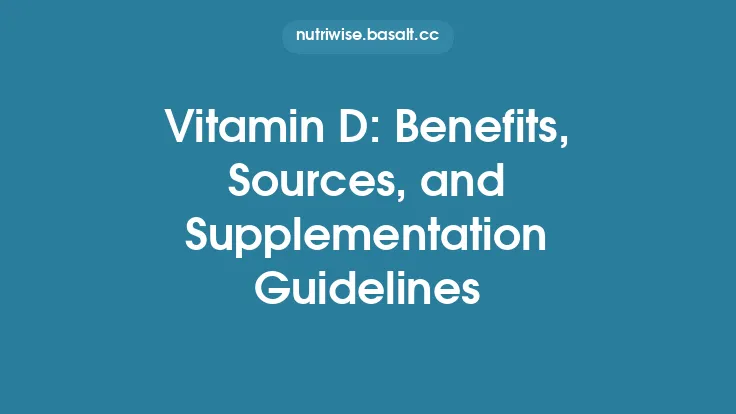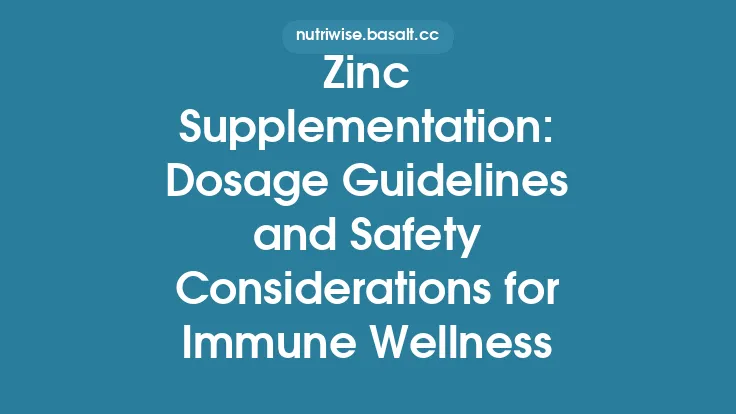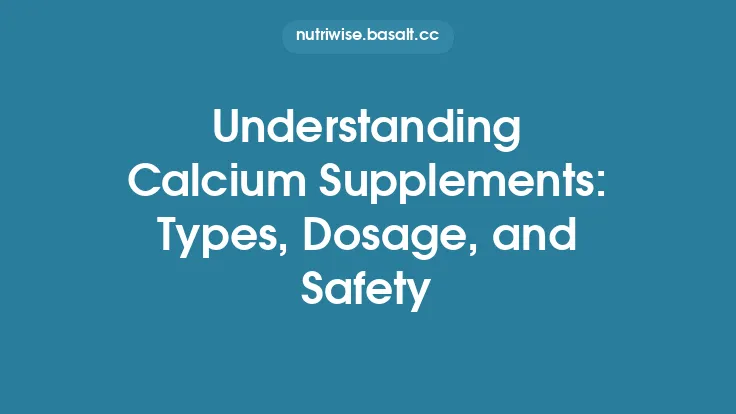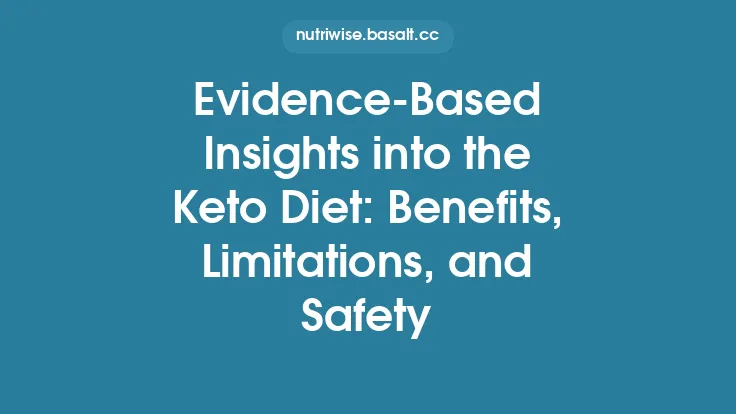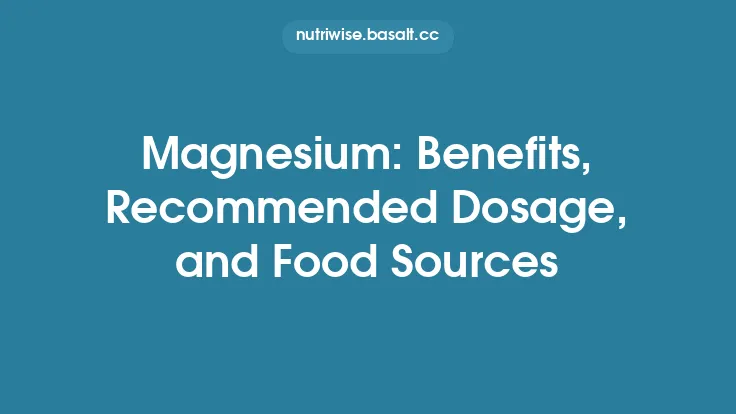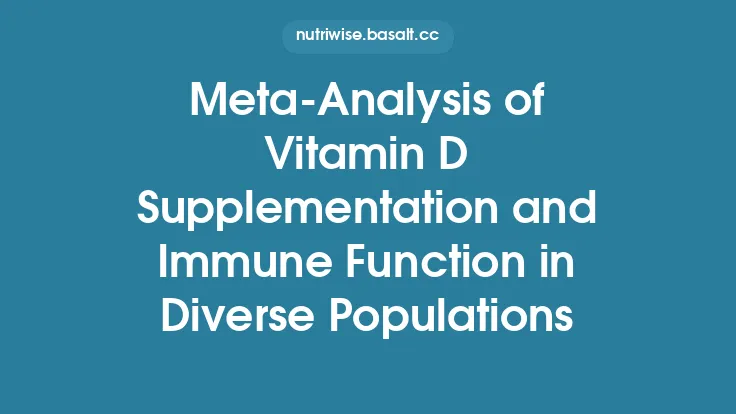Vitamin E supplementation has become a common strategy for individuals seeking to bolster their antioxidant defenses beyond what can be achieved through diet alone. While the nutrient’s fundamental role in protecting cellular structures from oxidative stress is well‑established, the decision to use a concentrated supplement involves a distinct set of considerations—ranging from the specific health outcomes that have been supported by clinical research to the nuances of dosage, formulation, and safety. This article delves into those aspects, offering a comprehensive, evergreen guide for anyone contemplating vitamin E supplementation as part of a broader micronutrient strategy.
Why Consider Supplementation?
- Limited Dietary Intake in Certain Populations
Even in regions where nuts, seeds, and vegetable oils are readily available, sub‑optimal intake can occur due to dietary restrictions (e.g., low‑fat or low‑calorie diets), food insecurity, or cultural eating patterns that exclude vitamin E‑rich foods. In such contexts, a supplement can help bridge the gap between actual and recommended intake.
- Increased Oxidative Load
Situations that elevate reactive oxygen species (ROS) production—intense endurance training, exposure to environmental pollutants, chronic inflammation, or certain medical conditions—may outpace the antioxidant capacity supplied by diet alone. Supplementation can provide an additional reservoir of tocopherols to counteract this heightened oxidative pressure.
- Genetic Variability in Metabolism
Polymorphisms in genes such as *α‑tocopherol transfer protein (α‑TTP) or CYP4F2* can affect the transport, distribution, and catabolism of vitamin E. Individuals with less efficient endogenous handling may benefit from a modest supplemental boost to achieve optimal plasma concentrations.
- Therapeutic Adjunct in Specific Clinical Scenarios
Evidence from randomized trials suggests that vitamin E supplementation can serve as an adjunct in certain disease states (e.g., non‑alcoholic fatty liver disease, certain neurodegenerative conditions, and specific forms of anemia). In these cases, the supplement is used not merely for “general health” but as a targeted component of a therapeutic regimen.
Evidence‑Based Health Benefits
| Health Domain | Key Findings from Peer‑Reviewed Studies | Practical Implications |
|---|---|---|
| Cardiovascular Health | Meta‑analyses of randomized controlled trials (RCTs) show modest reductions in LDL oxidation and improvements in endothelial function when 400–800 IU/day of natural α‑tocopherol is administered to individuals with elevated oxidative stress. | May be considered for patients with borderline dyslipidemia or early atherosclerotic changes, especially when lifestyle modifications are insufficient. |
| Neuroprotection | Longitudinal cohort data indicate that higher plasma α‑tocopherol levels correlate with slower cognitive decline in older adults. RCTs using 200–400 IU/day have demonstrated preservation of white‑matter integrity on MRI in mild cognitive impairment (MCI) cohorts. | Supplementation could be integrated into a multimodal approach for at‑risk seniors, alongside physical activity and cognitive training. |
| Immune Modulation | Controlled trials in elderly populations reveal that 200 IU/day of vitamin E enhances T‑cell proliferation and improves response to influenza vaccination. | May be recommended during flu season or for immunocompromised individuals to augment vaccine efficacy. |
| Metabolic Disorders | In non‑alcoholic fatty liver disease (NAFLD), 400 IU/day of natural vitamin E for 12 months reduced hepatic steatosis scores and serum transaminases compared with placebo. | Considered a first‑line adjunct in biopsy‑proven NAFLD when lifestyle changes are insufficient, per current hepatology guidelines. |
| Reproductive Health | Studies in men with idiopathic infertility have shown that 400 IU/day of vitamin E improves sperm motility and reduces oxidative DNA damage. | May be incorporated into fertility treatment protocols after baseline assessment. |
*Note:* The magnitude of benefit is often dose‑dependent and appears most pronounced when baseline vitamin E status is low or oxidative stress is high. Importantly, many of these benefits are observed with natural (d‑α‑tocopherol) rather than synthetic (dl‑α‑tocopherol) forms, reflecting differences in bioactivity.
Choosing the Right Form and Bioavailability
- Natural vs. Synthetic
- *Natural d‑α‑tocopherol* (derived from plant sources) exhibits a biological activity roughly 1.5–2 times that of synthetic dl‑α‑tocopherol because only the d‑isomer is biologically active.
- Synthetic preparations contain a racemic mixture of eight stereoisomers, of which only one is active, diluting the effective dose.
- Mixed‑Tocopherol Formulations
- While α‑tocopherol dominates most supplements, formulations that include γ‑tocopherol, δ‑tocopherol, and tocotrienols may provide broader antioxidant coverage.
- Emerging data suggest that mixed tocopherols can mitigate the “α‑tocopherol paradox,” where high α‑tocopherol intake suppresses plasma γ‑tocopherol levels.
- Liposomal and Soft‑Gel Delivery Systems
- Liposomal encapsulation improves intestinal absorption by bypassing the need for bile‑mediated micelle formation, which can be advantageous for individuals with malabsorption syndromes.
- Soft‑gel capsules protect the oil‑soluble vitamin from oxidation during storage, preserving potency.
- Dosage Form Considerations
- Oil‑based capsules are the most common and cost‑effective.
- Powdered or chewable tablets may contain emulsifiers to aid dispersion; however, they can have lower bioavailability if not properly formulated.
- Topical preparations are excluded from this discussion, as they fall under the “skin cell protection” domain.
When selecting a product, verify that the label specifies the IU (International Units) and the milligram (mg) equivalent (1 IU ≈ 0.67 mg of d‑α‑tocopherol). This conversion is essential for accurate dosing, especially when comparing products.
Recommended Dosage Ranges for Different Populations
| Population | Suggested Daily Intake (IU) | Rationale |
|---|---|---|
| General adult (18–64 y) | 200–400 IU of natural d‑α‑tocopherol | Aligns with the Recommended Dietary Allowance (RDA) of 15 mg (≈22 IU) plus a modest supplemental buffer to ensure plasma saturation. |
| Older adults (≥65 y) | 400–800 IU | Higher oxidative stress and age‑related decline in absorption justify a larger supplemental dose, especially for immune support. |
| Pregnant or lactating women | 200–300 IU | The RDA is 15 mg (≈22 IU); supplementation should not exceed 400 IU unless medically indicated, to avoid potential teratogenicity observed at very high doses in animal models. |
| Athletes & high‑intensity exercisers | 400–600 IU | To counteract exercise‑induced ROS production and support recovery. |
| Patients with NAFLD or metabolic syndrome | 400 IU (clinical trial‑based) | Evidence supports this dose for hepatic benefit; higher doses have not shown additional advantage and may increase bleeding risk. |
| Individuals on anticoagulant therapy | ≤200 IU, under physician supervision | Vitamin E can potentiate anticoagulant effects; a conservative dose minimizes hemorrhagic risk. |
| Children (1–12 y) | 30–100 IU (age‑adjusted) | Pediatric supplementation should be limited; consult a pediatrician before initiating. |
Upper Intake Level (UL): The Institute of Medicine sets the UL for adults at 1,000 IU (≈1,500 mg) of any form of vitamin E per day. Exceeding this threshold consistently raises the risk of adverse events, particularly hemorrhagic complications.
Safety Profile and Potential Adverse Effects
| Adverse Effect | Mechanism | Typical Dose at Which It Occurs |
|---|---|---|
| Bleeding tendency | Vitamin E interferes with vitamin K‑dependent clotting factor synthesis and platelet aggregation. | ≥800 IU/day, especially in combination with warfarin or antiplatelet agents. |
| Gastrointestinal upset | High‑dose oil capsules can irritate the mucosa. | >1,000 IU/day. |
| Headache & fatigue | Possible central nervous system effects of excess antioxidant activity. | >1,200 IU/day. |
| Altered thyroid hormone metabolism | Vitamin E can affect deiodinase activity, modestly lowering T3 levels. | >1,000 IU/day in susceptible individuals. |
| Increased all‑cause mortality (observational) | The relationship is controversial; some large cohort analyses have noted a slight rise in mortality at >1,500 IU/day, possibly reflecting confounding by underlying disease. | >1,500 IU/day. |
Overall, when used within the recommended ranges, vitamin E supplementation is well‑tolerated. However, clinicians should screen for concurrent anticoagulant use, vitamin K deficiency, and any history of hemorrhagic disorders before recommending higher doses.
Drug and Nutrient Interactions
- Anticoagulants (Warfarin, Direct Oral Anticoagulants)
Vitamin E can potentiate anticoagulant effects, increasing INR and bleeding risk. Monitoring of coagulation parameters is advised when initiating or adjusting vitamin E doses.
- Statins
Some statins (e.g., simvastatin) may reduce plasma α‑tocopherol levels by up‑regulating hepatic metabolism. Co‑supplementation can restore levels, but clinicians should watch for additive muscle toxicity.
- Chemotherapeutic Agents
High‑dose vitamin E may protect normal cells from oxidative damage but could also shield tumor cells from ROS‑mediated cytotoxicity. Use in oncology patients should be coordinated with the oncology team.
- Fat‑Soluble Vitamins (A, D, K)
Excessive vitamin E can antagonize vitamin K–dependent clotting pathways; however, it generally does not interfere with vitamins A or D at standard supplemental doses.
- Minerals (Selenium, Zinc)
Selenium works synergistically with vitamin E in membrane protection. Combined supplementation may enhance antioxidant capacity, but excessive selenium (>400 µg/day) can be toxic.
Monitoring and Adjusting Your Regimen
- Baseline Assessment
Measure plasma α‑tocopherol concentration (ideal range: 12–30 µg/mL). Low values (<12 µg/mL) suggest deficiency and may warrant a loading phase of 400–800 IU/day for 4–6 weeks.
- Follow‑Up Testing
Re‑measure after 8–12 weeks of supplementation. Aim for a plateau within the optimal range without exceeding 30 µg/mL, which could indicate oversupplementation.
- Clinical Markers
Track biomarkers of oxidative stress (e.g., malondialdehyde, F2‑isoprostanes) and inflammation (CRP) in research or high‑risk clinical settings to gauge functional impact.
- Adjustment Protocol
- If plasma levels are low and no adverse signs: increase by 200 IU increments.
- If levels approach the upper normal limit or bleeding signs appear: reduce dose or pause supplementation.
- For patients on anticoagulants, maintain the lowest effective dose and coordinate INR monitoring.
Special Considerations for Specific Groups
| Group | Unique Factor | Supplementation Guidance |
|---|---|---|
| Patients with Cystic Fibrosis | Malabsorption of fat‑soluble vitamins due to pancreatic insufficiency. | Use liposomal or oil‑based formulations with pancreatic enzyme replacement; target 400–800 IU/day. |
| Individuals with Hyperlipidemia on High‑Dose Statins | Statins may lower vitamin E levels. | Consider 200–400 IU/day of natural d‑α‑tocopherol; monitor liver enzymes and CK. |
| Post‑menopausal Women | Increased oxidative stress and bone turnover. | 400 IU/day may support bone health indirectly via reduced oxidative damage; ensure adequate calcium and vitamin D. |
| People with Chronic Kidney Disease (Stage 3–4) | Altered lipid metabolism and potential accumulation of fat‑soluble vitamins. | Start with low dose (100–200 IU) and monitor plasma levels; avoid high doses unless deficiency is confirmed. |
| Vegetarians/Vegans | Reliance on plant oils and nuts; possible lower intake of natural α‑tocopherol. | 200–400 IU/day of natural supplement is reasonable; choose products derived from soy or sunflower oil to align with dietary preferences. |
Practical Guidance for Incorporating Supplements
- Timing
- Take vitamin E with a meal containing dietary fat (≥5 g) to maximize micellar solubilization and absorption.
- Split dosing (e.g., 200 IU twice daily) can improve plasma stability for higher total daily intakes.
- Storage
- Keep capsules in a cool, dark place; exposure to heat and light accelerates oxidation of the oil matrix, reducing potency.
- Check expiration dates; vitamin E degrades over time, especially in soft‑gel form.
- Stacking with Other Antioxidants
- While this article avoids overlapping with “interaction with other antioxidants,” a brief note: pairing vitamin E with vitamin C can regenerate oxidized tocopherol, enhancing overall efficacy. Use balanced ratios (e.g., 500 IU vitamin E with 500 mg vitamin C) to avoid pro‑oxidant effects.
- Adherence Strategies
- Use a weekly pill organizer.
- Set a daily reminder on a smartphone.
- Pair the supplement with a habitual activity (e.g., after breakfast).
- When to Discontinue
- If you develop unexplained bruising, prolonged bleeding, or gastrointestinal distress.
- If plasma α‑tocopherol exceeds 30 µg/mL on repeat testing.
- Upon physician recommendation, especially before surgical procedures.
Current Gaps in Knowledge and Future Directions
- Long‑Term Cardiovascular Outcomes
While short‑term trials show favorable effects on oxidative biomarkers, definitive evidence linking vitamin E supplementation to reduced myocardial infarction or stroke incidence remains inconclusive. Ongoing large‑scale RCTs aim to clarify dose‑response relationships.
- Neurodegenerative Disease Modulation
The heterogeneity of Alzheimer’s disease pathology makes it challenging to isolate vitamin E’s impact. Future studies employing neuroimaging biomarkers and stratifying participants by baseline antioxidant status may yield clearer insights.
- Genotype‑Guided Supplementation
Emerging pharmacogenomic data suggest that individuals with specific *α‑TTP or CYP4F2* variants may require personalized dosing. Integration of genetic testing into clinical practice could optimize efficacy while minimizing risk.
- Synergistic Formulations
Research into combined tocopherol‑tocotrienol blends, especially those enriched with γ‑tocopherol, is exploring whether a broader spectrum of vitamin E isoforms can provide superior cellular protection without suppressing endogenous antioxidant networks.
- Safety in Ultra‑High Doses
The threshold at which vitamin E transitions from protective to potentially harmful (e.g., pro‑oxidant or hemorrhagic) is still being refined. Dose‑finding studies in specific high‑risk groups (e.g., patients on novel anticoagulants) are needed.
Bottom Line: Vitamin E supplementation, when thoughtfully selected and dosed, can serve as a valuable adjunct to dietary intake, particularly for individuals facing heightened oxidative stress, specific metabolic challenges, or documented deficiencies. By adhering to evidence‑based dosage ranges, choosing high‑bioavailability natural forms, and monitoring plasma levels and clinical markers, users can harness the micronutrient’s protective potential while minimizing safety concerns. As research evolves, personalized approaches—taking genetics, comorbidities, and concurrent medications into account—will likely become the gold standard for optimizing vitamin E’s role in cellular health.
